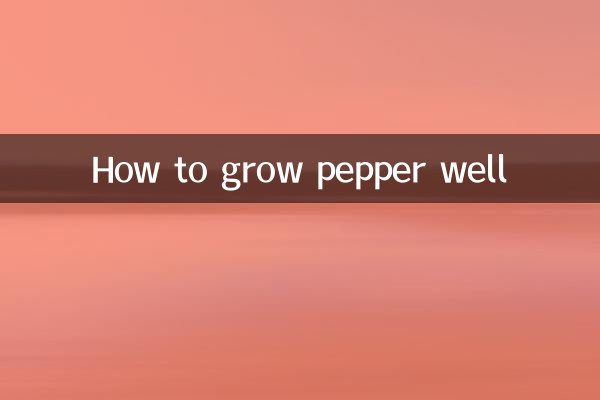How to grow peppers well: A complete analysis of the most popular growing tips on the Internet in the past 10 days
In the past 10 days, pepper cultivation has become a hot topic in the agricultural field, especially family cultivation and small farmers' attention to high-yield and disease-resistant varieties has increased significantly. This article will combine the hotly discussed planting technologies on the Internet to provide you with structured data guidance from seed selection to harvest.
1. Recommendation of popular pepper varieties (top 5 in the search list in the past 10 days)

| Ranking | Variety name | characteristic | Suitable planting area |
|---|---|---|---|
| 1 | Chaotian pepper | High spiciness and long fruiting period | south hill country |
| 2 | Colorful pepper | Rich color and high sweetness | Greenhouse planting |
| 3 | devil pepper | Super spicy, high medicinal value | arid areas |
| 4 | Thread pepper | High yield and strong disease resistance | Generally applicable nationwide |
| 5 | bell pepper | Thick pulp, durable for storage and transportation | northern temperate zone |
2. Control of key planting time nodes
According to the latest live broadcast data from agricultural experts, pepper planting needs to strictly grasp the following time window:
| growth stage | best time | Operational points |
|---|---|---|
| Seedling stage | The temperature is stable above 15℃ | Sterilize substrate and maintain humidity |
| Transplanting period | When the seedlings are 10-15cm tall | Transplant with soil to avoid root damage |
| flowering period | 40-50 days after transplanting | Control nitrogen fertilizer and increase phosphorus and potassium application |
| fruiting period | 20-30 days after flowering | Maintain a balanced hydration |
3. Five planting techniques that are hotly discussed on the Internet
1.New method of soil improvement: The "sandwich composting method" that has become popular on Douyin recently. The bottom layer is straw, the middle layer is kitchen waste, and the upper layer is garden soil. It is fermented for 15 days and then used. It can increase the soil organic matter content by 35%.
2.Water and fertilizer integration: The intelligent drip irrigation system recommended by Weibo’s agricultural influencer is controlled through a mobile APP, saving 40% of water while improving fertilizer utilization.
3.Pest and disease control: A recent Zhihu post pointed out that the key to preventing pepper disease is to dip the roots with Bacillus subtilis during planting, which is more environmentally friendly than chemical pesticides.
4.Yield-increasing dense planting plan: The "wide and narrow row planting method" actually tested by the UP owner of Station B. A wide row of 60cm is easy to operate, and a narrow row of 40cm increases the number of plants and increases the yield per mu by 20%.
5.Flowering period management: The "vibration pollination method" shared by Kuaishou anchor, gently shaking the plant every morning can increase the fruit setting rate by 15%-20%.
4. Solutions to common problems
| Problem phenomenon | Possible reasons | Solution |
|---|---|---|
| Serious defoliation | Excessive soil moisture/red spider mite damage | Improve drainage/spray orange peel essential oil |
| Fruit deformity | Poor pollination/calcium deficiency | Artificial assisted pollination/foliar calcium supplement |
| Plants are short | Soil compaction/root-knot nematodes | Deep soil plowing/solar disinfection |
5. Key points of harvesting and storage
Recent headlines emphasize that you should pay attention to the following when harvesting peppers:
• Harvest in the morning on a sunny day, keeping the fruit stems
• Graded packaging: First-grade fruit weighs >15g per fruit and has uniform color.
• For short-term storage, wrap in plastic wrap and refrigerate at 3-5℃
• Long-term storage can be used to make dried chili peppers (sun-dried until the moisture content is <14%)
Through the above structured data and the latest planting technology, I believe you will be able to grow high-yield and high-quality peppers. It is recommended to collect this guide, implement it at different growth stages, and pay attention to subsequent updated planting knowledge.

check the details

check the details